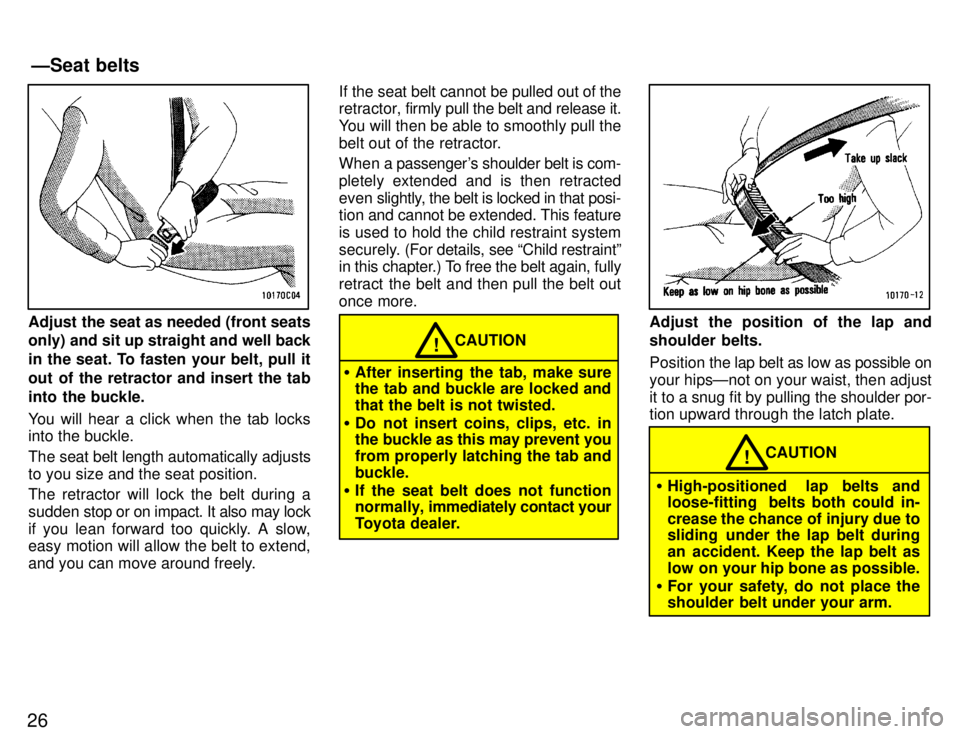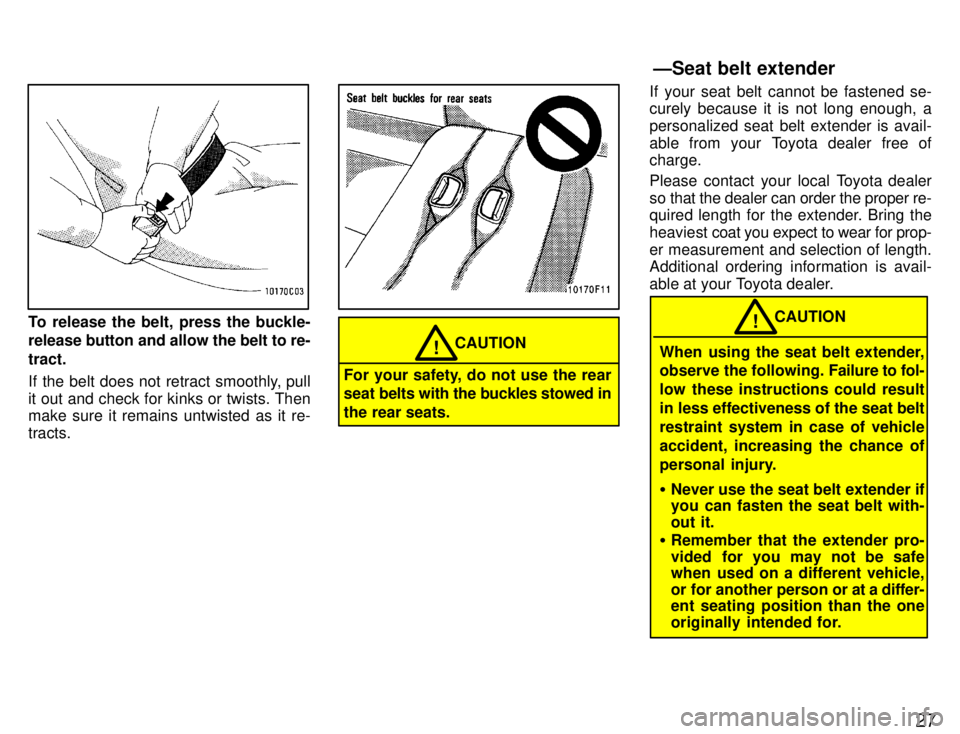Page 27 of 188

26
Adjust the seat as needed (front seats only) and sit up straight and well back
in the seat. To fasten your belt, pull it
out of the retractor and insert the tab
into the buckle.
You will hear a click when the tab locks into the buckle.
The seat belt length automatically adjusts
to you size and the seat position.
The retractor will lock the belt during a
sudden stop or on impact. It also may lock
if you lean forward too quickly. A slow, easy motion will allow the belt to extend,
and you can move around freely. If the seat belt cannot be pulled out of the
retractor,
firmly pull the belt and release it.
You will then be able to smoothly pull the
belt out of the retractor.
When a passenger's shoulder belt is com-
pletely extended and is then retracted
even slightly, the belt is locked in that posi-
tion and cannot be extended. This feature
is used to hold the child restraint system
securely. (For details, see Child restraintº
in this chapter.) To free the belt again, fully
retract the belt and then pull the belt out
once more.
CAUTION!
� After inserting the tab, make sure
the tab and buckle are locked and that the belt is not twisted.
� Do not insert coins, clips, etc. in
the buckle as this may prevent you
from properly latching the tab andbuckle.
� If the seat belt does not function
normally, i mmediately contact your
Toyota dealer.
Adjust the position of the lap and
shoulder belts. Position the lap belt as low as possible on
your hipsÐnot on your waist, then adjust
it to a snug fit by pulling the shoulder por- tion upward through the latch plate.
CAUTION!
� High-positioned lap belts and
loose-fitting belts both could in-
crease the chance of injury due to
sliding under the lap belt during
an accident. Keep the lap belt as
low on your hip bone as possible.
� For your safety, do not place the
shoulder belt under your arm.
ÐSeat belts
Page 28 of 188

27
To release the belt, press the buckle-
release button and allow the belt to re- tract.
If the belt does not retract smoothly, pull
it out and check for kinks or twists. Then make sure it remains untwisted as it re- tracts.
CAUTION!
For your safety, do not use the rear
seat belts with the buckles stowed in
the rear seats. If your seat belt cannot be fastened se- curely because it is not long enough, a
personalized seat belt extender is avail-
able from your Toyota dealer free of charge.
Please contact your local Toyota dealer
so that the dealer can order the proper re-
quired length for the extender. Bring the heaviest
coat you expect to wear for prop-
er measurement and selection of length.
Additional ordering information is avail-
able at your Toyota dealer.When using the seat belt extender,
observe the following. Failure to fol-
low these instructions could result
in less effectiveness of the seat belt
restraint system in case of vehicleaccident, increasing the chance of
personal injury. � Never use the seat belt extender if
you can fasten the seat belt with-
out it.
� Remember that the extender pro-
vided for you may not be safe
when used on a different vehicle,
or for another person or at a d iffer-
ent seating position than the one
originally intended for.
CAUTION!
ÐSeat belt extender
Page 123 of 188

121
Toyota does not recommend towing a
trailer with your Supra. It is not designed for trailer towing.Getting
more kilometers/mileage from a li-
ter/gallon of fuel is easyÐjust take it easy.
It will help make your vehicle last longer,
too. Here are some specific tips on how to
save money on both fuel and repairs: � Keep your tires inflated at the cor- rect pressure. Underinflation causes
tire wear and wastes fuel. See Chapter
7-2 for instructions.
� Do not carry unneeded weight in
your vehicle. Excess weight puts a
heavier load on the engine, causing greater fuel consumption.
� Avoid lengthy warm-up idling.
Once the engine is running smoothly,
begin drivingÐbut gently. Remember,
however, that on cold winter days this
may take a little longer.
� Accelerate slowly and smoothly.
Avoid jackrabbit starts. Get into high
gear as quickly as possible.
� Avoid long engine idling. If you have
a long wait and you are not in traffic, it
is better to turn off the engine and start
again later.
� Avoid engine lug or overrevving.
Use a gear position suitable for the
road on which you are travelling. �
Avoid continuous speeding up and
slowing down. Stop-and-go driving
wastes fuel.
� Avoid unnecessary stopping andbraking. Maintain a steady pace. Try
to time the traffic signals so you only
need to stop as little as possible or take
advantage of through streets to avoid
traffic lights. Keep a proper distance
from other vehicles to avoid sudden braking. This will also reduce wear on your brakes.
� Avoid heavy traffic or traffic jams
whenever possible.
� Do not rest your foot on the clutch
or brake pedal. This causes needless
wear, overheating and poor fuel econ-
omy.
� Maintain a moderate speed on highways. The faster you drive, the
greater the fuel consumption. By re-
ducing your speed, you will cut down
on fuel consumption.
� Keep the front wheels in proper alignment. Avoid hitting the curb and
slow down on rough roads. Improper
alignment not only causes faster tire
wear but also puts an extra load on the
engine, which, in turn, wastes fuel.
� Keep the bottom of your vehicle
free from mud, etc. This not only
lessens weight but also helps prevent corrosion.
How to save fuel and make
your vehicle last longer, too
Trailer towing
Page 181 of 188
Part 8Dimensions and weight Engine
179
SPECIFICATIONS �
Dimensions and weight
�Engine
�Fuel
�Service specifications
�Tires
�Fuses
Overall length mm (in.) 4515 (177.7)
Overall width mm (in.) 1810 ( 71.3)
Overall height mm (in.) 1265 ( 49.8)*
�
1275 ( 50.2)* �
Wheelbase mm (in.) 2550 (100.4)
Front tread mm (in.) 1520 ( 59.9)
Rear tread mm (in.) 1525 ( 60.1)
Vehicle capacity weight (occupants + luggage) kg (lb.) 330 (725)
* � : Unladen vehicle plus two occupants
* � : Unladen vehicle Model:
2JZ-GE and 2JZ-GTE
Type: 2JZ-GE engine 6 cylinder in line, 4 cycle, gasoline
2JZ-GTE engine 6 cylinder in line, 4 cycle, gasoline (with turbocharger)
Bore and stroke, mm (in.): 86.0 x 86.0 (3.39 x 3.39)
Displacement, cm 3
(cu. in.):
2997 (182.9)